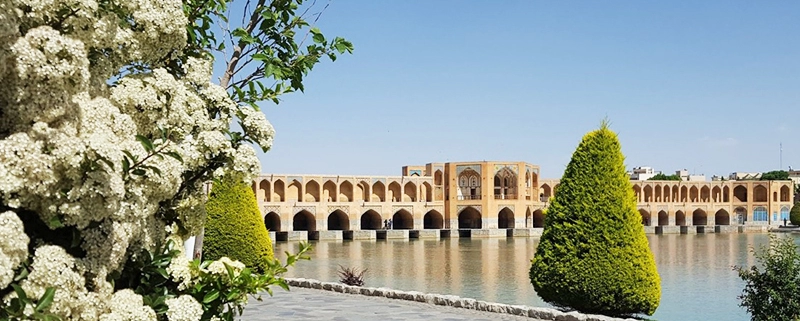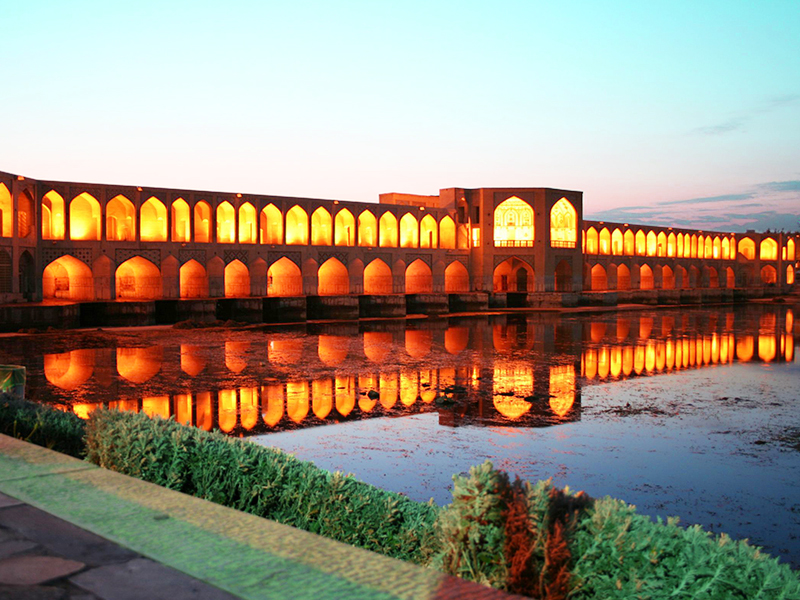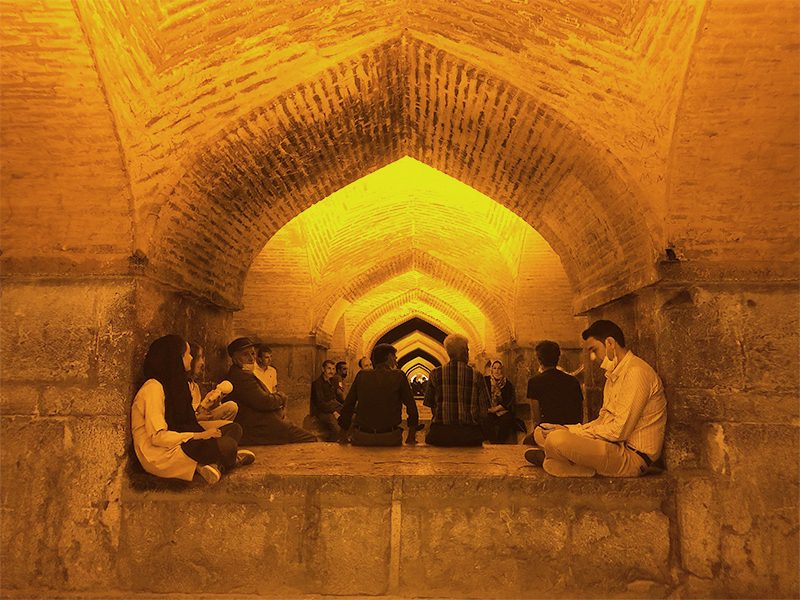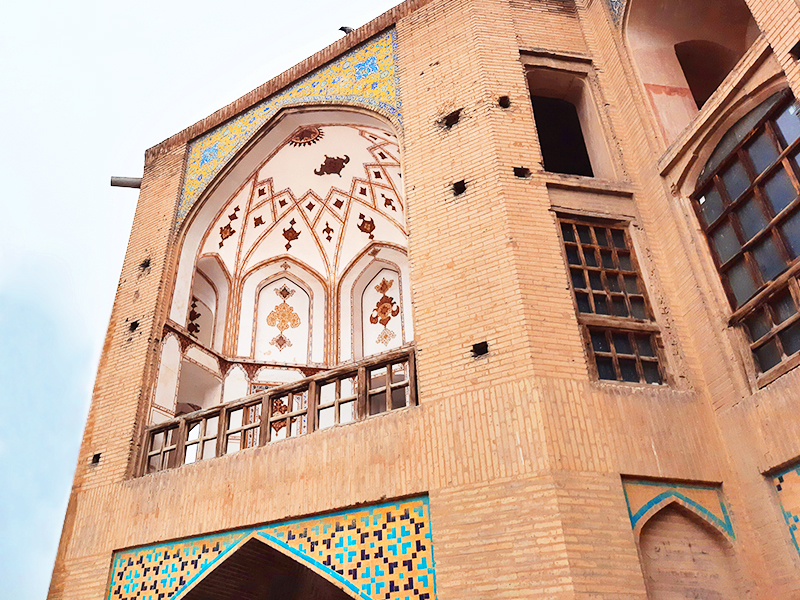Khaju Bridge in Isfahan, Iran: Photos, Facts, Height
Khaju Bridge is one of the many bridges spanning the Zayandeh Rud River, which is known as the most beautiful bridge in Isfahan. Situated east of the Si o Se Pol Bridge, this architectural masterpiece not only fascinates with its eye-catching design but also showcases exquisite paintings. Commissioned by Shah Abbas II of the Safavid dynasty and constructed on the ruins of the Hassan Bek Bridge from the Timurid era, the Khaju Bridge gained fame in its time as one of the world’s most beautiful bridges due to its architectural features and the use of intricate tilework decorations. Due to its historical importance, Khaju Bridge has been listed as a national heritage of Iran since January 15, 1932, and this emphasizes its lasting cultural and architectural value. To learn more about this magnificent bridge, stay with us until the end of the article.
Khaju Bridge History
Khaju Bridge is one of the most beautiful historical buildings in Iran. It was established by Shah Abbas II during the Safavid era and is located on the Zayandeh Rud River in Isfahan. Also known as Shah Bridge, Baba Rokn al-Din Bridge, Hasanabad Bridge, Shahi Bridge, and Shiraz Bridge, it is situated in the eastern part of the Si-o-Se-Pol Bridge, another historical site in Isfahan, with a distance of approximately 1800 meters between them.
The bridge gets its name from the Khaju neighborhood in Isfahan, and “Khaju” is a modification of the term “khajeh,” expressing respect for figures from the Safavid era. Located at the end of Kamal Esmaeil Street in Isfahan, the bridge served Shah Abbas II’s goal of connecting the Khaju neighborhood with Takht-e Foulad and the Shiraz route. After its construction, it was repurposed as a dam. Notably, the eastern and western sections of the bridge house decorated structures, providing a venue for swimming and boating competitions observed by kings and courtiers.
How Old Is the Khaju Bridge?
Khaju Bridge was built in the year 1681 under the command of Shah Abbas II of the Safavid dynasty. Originally named Hasan Beik, the bridge had its origins in the Timurid era. However, Shah Abbas II ordered the demolition of this bridge and subsequently commissioned the construction of the beautiful and historic Khaju Bridge.
Why Is Khaju Bridge Famous?
Khaju Bridge is famous worldwide for its stunning architectural design, featuring intricate tilework, decorative elements, and overall aesthetic appeal that adds to its fame as one of the most beautiful bridges in Isfahan. Beyond its visual charm, the bridge serves as a cultural symbol, reflecting the artistry and engineering skills of its time and standing as an iconic representation of Persian bridge architecture and design. Its status as a tourist attraction further enhances its fame, attracting visitors from around the globe who come to admire its beauty, delve into its history, and experience the unique atmosphere created by its architecture and surroundings.
What Are the Facts About the Khaju Bridge?
Stone Lions: On both sides of Khaju Bridge, impressive stone lions capture attention. Standing beside one of these lions and gazing into its eyes reveals a gleaming effect. Some believe these two stone lions symbolize the brave warriors of the Bakhtiari tribe who bravely guard Isfahan and the Zayandeh Rud River. The inscriptions on the bodies of these lions are said to be the initials of the sculptors, with additional symbols representing ancient sports.
Qibla Indicator: Located on a stone platform near the north side of the bridge, close to one of the stone lions, is a Qibla indicator. This feature adds an enticing element for tourists, as it historically served as a directional guide.
Khaju Candle: The Khaju Candle is a unique feature, especially when viewed at a 30-degree angle from the east, looking out towards the bridge’s lower arches. The interplay of the arches creates a visually stunning effect, particularly during sunset.
Stone Slabs on the Walls: Walking under the bridge, one encounters stone slabs of varying dimensions on the walls, each marked with unique symbols. These symbols are believed to be the signatures of artists responsible for installing the slabs. This practice not only ensured proper placement but also left a lasting impression on the artisans.
Peculiar Tombstones: In 2009, several ancient tombstones accompanied by carved stone slabs adorned with peculiar symbols were discovered under the bridge. Some of these tombstones are now housed in the Takht-e Foulad Stone Museum.
What Type of Bridge Is the Khaju Bridge?
Khaju Bridge is a multi-functional bridge that serves both as a river crossing and a recreational space. Architecturally, it is classified as a “multi-span, stone-built bridge” with 23 arches. The bridge spans the Zayandeh Rud River in Isfahan, Iran, and its unique design and historical significance make it a notable example of Persian bridge architecture. The bridge not only facilitates transportation but also features a central building designed for leisure and residence, showcasing the bridge’s multi-purpose nature.
What Is the Khaju Bridge Made of?
In terms of foundation, Khaju Bridge’s base rests on a stony structure made of coarse-grained pieces called ” Conglomerate,” creating a resilient layer. During construction, layers of river sand and gravel were placed beside the bridge, and the bridge’s foundation was built on a layer of Conglomerate. The riverbed next to the bridge’s base is paved with stones to minimize the erosive effects of water, such as erosion and scouring. This thoughtful bridge design ensures that, to this day, there is no visible sign of erosion or scouring around its foundations.
A closer inspection of the large, precise, and heavy foundations of Khaju Bridge reveals that the dimensions of the bridge have been well-calculated in all directions, withstanding the pressure of water for many years despite its considerable weight. The pressure from the river’s flow and the static pressure of the water around the bridge’s foundations could threaten the structure’s integrity. Weight is a crucial factor in resisting these pressures, but it alone is not sufficient. In Khaju Bridge, the extensive contact surface between the bridge and the riverbed and the shape of the bridge’s foundations play significant roles in its strength. Issues such as foundation slippage, tilting, and more are irrelevant to Khaju Bridge.
The foundations beneath the arches are made of large, heavy stones, resembling the heads of spillways and step weirs. A spillway is a transverse structure that directs the flow of water toward the center of the river and reduces its speed to preserve the riverbanks.
Khaju Bridge Height
The historical Khaju Bridge spans a length of 133 meters and has a width of 12 meters, supported by 23 arches. The height of this spectacular bridge is 11 meters. In its central section, a graceful structure named “Beylerbey” stands, adorned with intricately designed arches. This elegant building was specifically designated by Shah Abbas II for his Safavid family, providing a place for their recreation and relaxation. The bridge has stood the test of time since its completion, embodying centuries of history and cultural significance.
Khaju Bridge Facts
One of the most attractive secrets of Khaju Bridge lies within its candles. Standing under the bridge, one can observe a candle formed by the intersection of the three-dimensional space and the collision of the back and front walls. This candle is fully visible, creating a captivating sight. When viewed from above, the bridge’s structure looks like an eagle with its wings spread wide, as if it is flying over the Zayandeh Rud River. The different levels of the bridge depict an eagle’s feathers, and the elevated platforms, known as Shah Neshin, on the second floor, resemble the head of an eagle.
During the restoration and reconstruction of the bridge, excavations revealed ancient tombstones alongside numerous carved stone slabs adorned with exotic symbols. These discoveries add an extra layer of historical and archaeological significance to the Khaju Bridge.
Khaju Bridge Reviews
Khaju Bridge in Isfahan is highly praised for its stunning architecture, beautiful tilework, and historical significance. Reviewers highlight its elegance and symmetry, noting it as a must-see landmark. The bridge is also a popular gathering place for locals, especially in the evenings.
Positive aspects highlighted in reviews:
Architectural beauty
Many reviewers admire the bridge’s design, including its arches, tilework, and overall structure.
Atmosphere
The bridge is described as a lively place, especially at night, with locals singing and enjoying the ambiance.
Historical significance
The bridge’s rich history and cultural importance are also noted.
Photography opportunities
The bridge is considered a great spot for photography, particularly at night when it’s illuminated.
Unique features
Some reviewers mention the two stone lions at the bridge’s ends and the echo effect within the alcoves.
Points to consider:
River condition
The Zayanderud River, which the bridge crosses, has reportedly dried up in recent times. While the bridge is still worth visiting, some reviewers note the impact of the dry riverbed on the overall experience.
Crowds
The bridge is a popular attraction, so it can be crowded, especially during peak hours.
Local culture
Reviewers highlight the opportunity to experience local culture, with locals gathering, singing, and enjoying the bridge.
Khaju bridge location
Final Word
Khaju Bridge is a valuable example of Iran’s rich history and cultural importance, especially during the Safavid period. Commissioned by Shah Abbas II, this marvel not only showcases stunning design, intricate tilework, and decorative elements but also serves as a cultural symbol, connecting neighborhoods and providing recreational spaces. The stone lions, Qibla indicator, Khaju Candle, and unique stone slabs add to its allure. Beyond its historical and artistic appeal, Khaju Bridge is a functional masterpiece, with a central building and a role as a dam. For tourists, it offers a unique experience to admire its beauty and learn about its history. A visit to Iran would be incomplete without witnessing the beauty and historical charm of Khaju Bridge, a destination that showcases the art, history, and peaceful atmosphere of Isfahan.
Are you planning to travel to Iran and looking for an Iran travel agency? Check out our Iran tours and feel free to contact us. Here are more interesting things to do in Isfahan.









Leave a Reply
Want to join the discussion?Feel free to contribute!